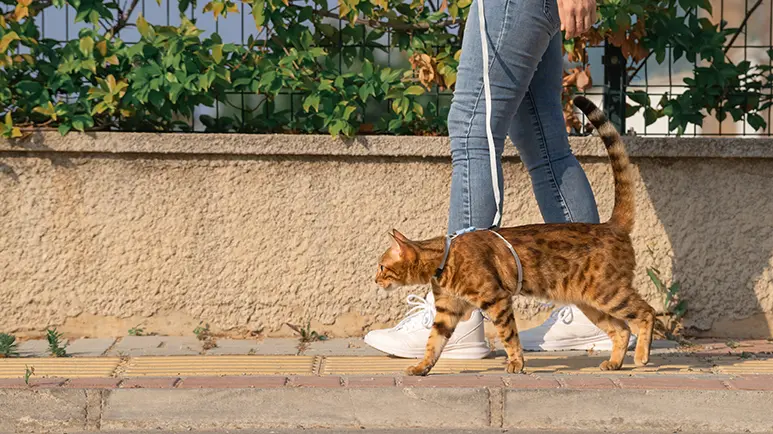Why Indoor Cats Benefit From Time Outdoors
Most cat experts agree on one thing: whenever possible, felines should be offered protected, controlled access to the outdoors for their physical and mental well-being. But how do you do that if yours is an indoor-only kitty, or you live in an urban area?

STORY AT-A-GLANCE
- The idea of giving indoor cats outdoor access has its advocates and detractors; what most cat experts agree on, however, is that whenever possible, felines should be offered safe, controlled access to the outdoors
- Most feline family members can derive great enjoyment and mental stimulation from supervised trips outside, and they also benefit whenever they’re able to put their paws in contact with the earth
- Many cats, and especially kittens, can be trained to walk on a harness and leash, allowing them to safely experience the great outdoors; the type of equipment you buy is important, as is the type of training and encouragement you offer
- An alternative positive experience for kitties who can’t or won’t be walked is an outdoor cat enclosure, or “catio”
Editor's Note: This article is a reprint. It was originally published September 28, 2021.
Like so many pet-related topics, there are two schools of (passionate) thought on the idea of walking cats outdoors on a leash. On one side of the divide, you have advocates of cat walking who believe that if kitty will put up with it, it’s a great way to allow indoor-only felines time in the great outdoors, which puts their paws in direct contact with the earth and offers both mental and physical stimulation.
An argument against the practice, as described by Tasha Bukovnik, president of the Vancouver (BC) Orphan Kitten Rescue Association, goes as follows:
"We get calls on a regular basis to come look for cats that have been lost because they've been taken out, they've escaped their carrier or they've escaped from their harness.
Most of the time, we never find them again. Or if we do, it's really in sad circumstances, where we only find a part of the cat."1
Cats Are Safer, but Not Always Happier Indoors
In Bukovnik’s opinion, cats are happiest indoors. She said if someone feels their cat could benefit from outdoor exposure, they should consider a window enclosure or "catio" instead. While Bukovnik, as president of a kitten rescue organization, has probably seen many tragic situations involving abandoned cats, I disagree that felines are “happiest” indoors, though they are certainly safer.
I also disagree that cats “could” benefit from safe exposure to the outdoors — there’s no question most do. And while a window enclosure is nice for bird watching, it doesn’t get kitty outside, however, a catio (“cat patio”) does.
Burnaby, BC veterinarian Dr. Claudia Richter agrees a catio is a great option and shares Bukovnik’s concern about cats escaping from harnesses. Richter believes giving cats access to the outdoors, including leash walks, can be beneficial if done correctly.
"A lot of our cats are under-stimulated, and I do see this as a source of behaviour problems, such as peeing in the house, anxiety disorders, things like that," Richter told CBC News.2
In fact, Richter has walked her own cat, Winnie, on local trails and around her neighborhood, though she admits it was a learning experience.
"I had that expectation ... that I would be able to walk her to work with my dogs, which very quickly got destroyed by the fact that my cat is just really slow," she said. "It's her walking and we're just following her with the leash ... as a sort of security officer."
Is Your Cat a Good Candidate for Leash Walks?
It’s very important to be aware that while most cats, and especially kittens, can be trained to walk on a harness and leash, your kitty could be an exception.
If you suspect your cat would never under any circumstances, be agreeable to walking on a leash, or would be so terrified by the experience that she could be psychologically damaged, chances are you're probably right. It’s important to never force anything on your kitty.
I have one inquisitive cat that I easily trained to wear a harness and she loves going outside. I have another kitty that I would never even consider walking outdoors … she’s too fearful and would find the experience terrifying, not enjoyable. It’s important to not force your cat to do anything, and even training her for the experience of stepping outside must be done at a pace that honors her personality.
Some cats, especially seniors, will naturally be reluctant to wear a harness, be tethered to a leash, or put so much as a paw outdoors. Only you can decide whether the stress of a walk or spending time outdoors with you on a leash outweighs the benefits for your cat.
Selecting a Harness and Encouraging Kitty to Wear It
There are few creatures on earth as flexible as a cat, so attaching a leash to a collar is asking for trouble. Not only are kitties notorious for slipping out of their collars, but if your cat runs up a tree, a standard collar could strangle him, and a breakaway collar will detach.
Invest in a harness designed specifically for cats, or something along the lines of the Kitty Holster or Walking Jacket. The leash clip is toward the middle of these harnesses rather than the neck, which is much safer and less stressful for your kitty.
The harness should fit snugly to your cat’s body, but not so tight that airflow is constricted. Make sure you can slip two fingers under the harness at the neck and under the chest. The harness clips should snap securely and should not be the breakaway style used on some cat collars.
Very few cats take right away to wearing a harness. That’s why verbal praise, head scratches, and especially, healthy food treats will be your friends during harness training sessions. And be sure to plan these sessions for when your cat is hungry.
Break the treats into tiny pieces, because your kitty’s willingness to cooperate will decrease as her tummy fills up. Cats aren’t people-pleasers, so food treats are their primary incentive. And remember to present treats within a second or so of a desired behavior.
Training begins as soon as you bring the harness home. Put it near your cat’s napping spot or food bowl and let her get used to the sight, smell and feel of it. When she shows interest in it, praise her, and give her a treat. After a few days of this, while holding your cat, give her a treat, drape the harness over her, and leave it for a minute or two.
Use your cat’s response and comfort level to decide the best time to secure the harness on her body. Make sure to keep the praise, petting, and yummy treats coming.
Leave the harness on kitty for a few minutes to start, and gradually increase the time she wears it. And remember: Don’t force anything on your cat. If she is really struggling against the harness, remove it and try again later. The goal is to have her associate wearing the harness with good things.
Adding a Leash to Your Cat’s Walking Gear
Once your cat is walking around comfortably in his harness, it’s time to attach the leash. Use a flat cat leash, not a retractable leash. Initially, you just want him to walk around the room with the leash attached so he can get used to the feel of it. During this time, you’ll want to keep a close eye on him to make sure the leash doesn’t get caught on anything, and of course, offer treats, praise and petting as he moves around with the leash.
When he gets used to the presence of the leash, you can begin walking him around the house on it. Don’t pull the leash or drag him with it. Let him lead, while you follow and offer treats and praise at regular intervals. If you don’t want him to walk in a certain direction, hold the leash with no slack, signaling he can’t go any further.
Allow him time to learn leash communication, so he knows what you’re signaling before you step outside. Get him used to being picked up with the leash and harness on, in case you need to quickly secure him outside.
Once he seems comfortable being walked around the house, offer the first outdoor opportunity. After making sure your destination is safe and secure, open the door and let kitty take the lead. He may be quite tentative at first, but gradually, there’s a good chance he’ll get curious enough to start investigating all the new smells, sights, and sounds beyond his front door. If not, try again tomorrow.
Once your cat’s curiosity has overridden his fear, you can allow him to lead you down the sidewalk, into the yard, or even around the block if he’s up for it. But keep in mind that depending on his temperament, you could easily spend the next month just getting down the front walk or onto the grass. Or just hanging out on your front step.
If you live in an apartment building, you’ll also need to acclimate your cat to a carrier, without causing stress. Once she associates the carrier with an enjoyable outdoor adventure, you’ll be on your way. Make sure to put the harness on her while she’s inside, then once you’ve reached your safe outdoor destination, open the carrier door, and let her come out on her own. Keep adventures short, returning home before she exhibits any signs of stress.
Additional Tips for Leash Walks With Your Cat
- If your neighborhood has lots of traffic noise, free-roaming cats or dogs, or other distractions your kitty seems threatened by, you’ll need to find a quieter, safer area where she feels less overwhelmed.
- Choose spray-free grass, and make sure kitty doesn't pick up anything in his mouth or lick anything. And no tree climbing for leashed cats. It's too dangerous.
- Don't tie your cat's leash to something and leave her outside, even for a minute. If something spooks her, she could get tangled in the leash. If she feels threatened by another animal or person, she can't get away. Never leave your cat outside unattended for any reason.
- Expect setbacks. Your cat might be okay in a new area on Monday and when you take him there on Tuesday, something freaks him out. Step back to the last place he was comfortable and start moving forward with baby steps again.
And unless he’s in harm's way, resist the urge to pick him up if something spooks him. It's better for his confidence if you can leave him on the ground, with the door to your house or the carrier open, so he has a safe spot he can return to at any moment.
A Great Alternative to Leash Walks
An alternative to walking your cat is an outdoor enclosure. Many people are installing “catios” and similar types of outdoor spaces that allow feline family members safe, secure access to the outdoors.
You can go as simple or sophisticated as you like with these enclosures. The one below, which belongs to a client of mine, is quite posh, but there are very simple designs as well. You can purchase one or go the do-it-yourself route.

If you’re in a situation in which both leash walks and a catio are out of the question, your next best option is to make absolutely sure your feline family member is getting plenty of daily cat-centric exercise.
Sources and References
- MSN.com, July 19, 2021
- 1,2 CBC News, May 21, 2021











